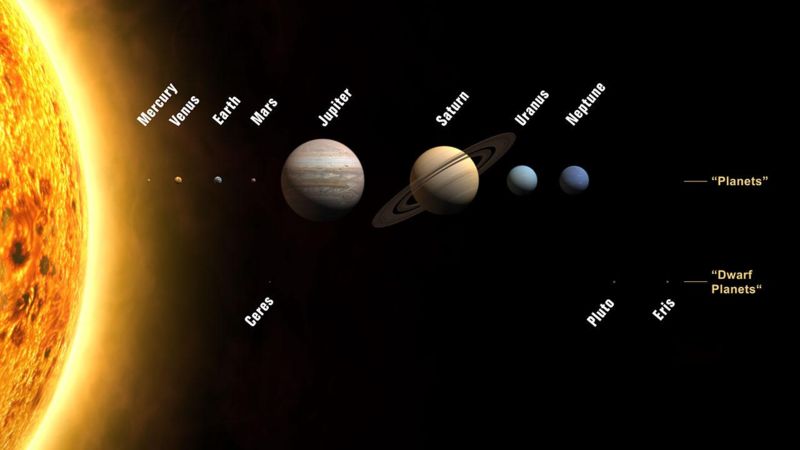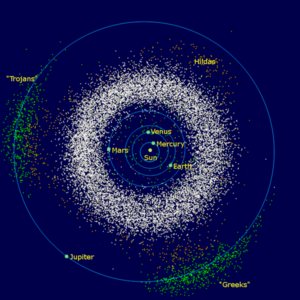How to make a Solar System
Interview with
Our Solar System contains a great diversity objects from the Earth we're standing on to asteroids that as we've just heard, there are companies hoping to mine. These objects range from massive gas giants like Jupiter, right down to clouds of microscopic dust. But we're not sure how it all formed. Research using computer models is helping to shed some light on this problem and to find out how, Ben Valsler spoke to Alan Jackson, a PhD student in the Institute of Astronomy in Cambridge.
Alan - I've always been interested in asking how did Earth get here? Why do we have this nice planet we live on? How do we end up with planets like Earth? Are there likely to be any others?
Ben - Are there any examples out there in the universe that we can actually use to see this happening or do we have to rely on what we see here in our own Solar System and extrapolate backward s?
s?
Alan - There are some places where we think terrestrial planet formation is going on. All of this is quite new in terms of people going out and looking at it. We're probably certain there must be places that it's happening. We're still trying to find them. The first extrasolar planet around a star like our Sun was found I think in 1995. So, it's really not that long ago at all.
Ben - That's not given you a lot of time to find examples that you can use!
Alan - No, exactly. The first one was in 1995. I think the second one was in 1997. It's only really in the last 10 or 15 years that's really beginning to pick up speed.
Ben - So, in the absence of systems that we can look at and watch it happening, how do you actually start to understand the processes that are going on?
Alan - If you can't see it going on, then what you have to do is look at what you end up with. We know to a reasonable degree what they must have started like because we can see protoplanetary disks, these big disks of dust and gas that are around young forming stars. How do we get from that to planets?
Ben - And how do you fill that gap in? What do you have to use to actually start answering that question?
Alan - Lots of computer simulations. For the very early stages where  you're looking at the gas and dust and how that gas and dust starts to collapse down to produce some little asteroid-like objects. Because that's mostly gas, we'll be looking at fluid type situations. Later on, when the gas is gone and you just have lots of bits and pieces of rocks that have stuck together, and you've got various different size lumps then you're looking more at just stimulating those individual particles and colliding them with each other.
you're looking at the gas and dust and how that gas and dust starts to collapse down to produce some little asteroid-like objects. Because that's mostly gas, we'll be looking at fluid type situations. Later on, when the gas is gone and you just have lots of bits and pieces of rocks that have stuck together, and you've got various different size lumps then you're looking more at just stimulating those individual particles and colliding them with each other.
Ben - So you have to rely on some basic physics to tell you what should be going on.
Alan - Yeah.
Ben - But then it must be very difficult to integrate and to work out when we stop using the physics of fluid dynamics and we start using gravity and other accretion models.
Alan - It is, yes. Guessing the boundary between them is quite difficult. Sometimes they don't quite match up properly. It's not particularly uncommon for people or different groups to be simulating different aspects of the evolution of these type of things, and the results of one group doesn't quite match up with what other group is doing. Basically, you just need to talk to each other and try and work out what's causing it to not match up. If you can do that then do it again, it does it match up? Yes? good. No? Okay maybe not, lets try again.
Ben - So, that way, lots of different groups all over the world can actually refine their models until we come to an understanding of what we think really has happened?
Alan - Yes, and then of course there's the observational side which is, now we need to try and go and find something out there that's in the process of doing this, and see if it actually looks like that.
Ben - This is obviously a very good way to make very well-refined models that show how this cloud of gas and dust becomes the planets and the objects that we know about. But unfortunately, things are never quite that straightforward and we know from looking at the planets in our Solar System that there has been some almighty collisions and hails or new objects. How do you account for the actual quite destructive nature of our Solar System?
Alan - It's one of the big problems actually with these things, getting the planets to not just blow each other up and actually, it's with the smallest objects that this is the biggest problem because obviously, the smaller something is, the less gravity it has. So, getting them to stick together without destroying each other is quite hard. Once you get up to things the size of Earth, although you do get these incredible collisions that are very, very violent, because the Earth is - comparatively speaking - quite big and has a lot more gravity holding it together, it's a lot more difficult to actually completely destroy it. It can happen, but it's a little bit more difficult to do.
Ben - How do we account now for the diversity of objects that we see in the Solar System? We have gas giants, we have terrestrial planets like Earth and Mars, but we also have these bands of asteroids that clearly haven't accreted into a planet in the same way that Earth has. How can the models make sure all of those fit and are in the right place?
Alan - Well, with the asteroid belt, the main reason that we have the asteroid belt is Jupiter. If Jupiter wasn't there or hadn't formed where it is then probably, the asteroid belt would either have like accreted on to Mars and so Mars would be bigger, or it would have formed a terrestrial planet. But because Jupiter is so very massive, it stirs up the material nearby to much higher velocities, so that early process that I've mentioned where trying to get things to stick to each other is a bit more difficult, it just doesn't happen.









Comments
Add a comment